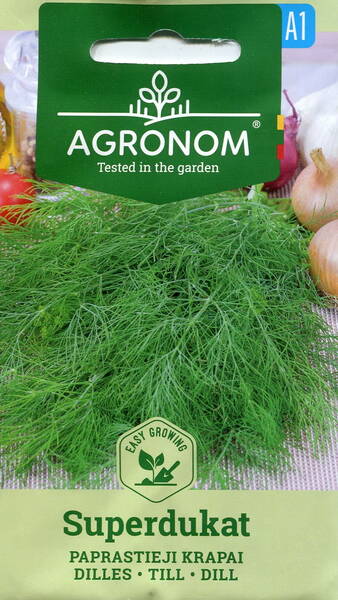Ex Tax: 0.65€
Medium early variety. Semi-spreading rosette, with 7-9 large leaves, 33-37 cm high. Green leaves with a slight waxy coating. Seed bush up to 134-145 cm high.
The formation of stems and umbrellas is slow. The variety has a high yield, strong aroma, and relative disease resistance. The taste is high.
* Growing dill is not difficult, but you need to know some of its features.
This culture loves loose, fertile soil, and does not grow well on compacted heavy soils. Dill is especially affected in the lowlands, where water stands close to the surface and reacts very poorly to a lack of air. Under such conditions, the plants acquire a characteristic yellow-violet colour. After heavy rains, the formation of a crust around the dill plant should not be allowed - it will prevent air from reaching its roots.
When is the best time to sow dill?
It can be sown at different times, it is only necessary to create conditions for seed germination and, above all, provide it with a sufficient amount of moisture. Dill can be sown even before winter, from late October - early November. You can sow it in early spring, as soon as the snow melts. At the same time, seed consumption is increased to 10 grams per 1 m2. With normal sowing in May and summer, you can sow 5 g of seed per 1 m2, and bush varieties - and 2 g per 1 m2.
When sowing in the winter and early spring, it is a good idea to cover the young seedlings with covering material, which will save the plants from severe frosts.
Dill can be sown on other crops, but it is better to grow it on a separate bed. To do this, the seeds are sown in rows. The distance between rows is 20-25 cm for the convenience of weeding and loosening, and in a row, between plants, 2-3 cm and they are gradually thinned out.
Do seeds need to be soaked?
This technique makes it possible to obtain quick and friendly seedlings, but only on the condition that the soaked seeds are sown in moist soil and do not allow to dry out before germination. Otherwise, in the dry land, seeds that have hatched will die from lack of moisture.
Soaking seeds can be done at home 2-3 days before planting. Seeds are placed in a linen bag or old tights are used for this. The main thing is that water easily penetrates through the matter. A bag of seeds is placed in a container of hot tap water, then, as the water cools, it is changed several times during the day. After that, the next day, the seeds from the bag are poured onto a damp cloth, dried and sown. Before germination, crops are watered and weeded from weeds.
In the first 2-3 weeks, dill grows slowly and is very oppressed by weeds and thickened seedlings. Therefore, a bed with dill must be kept clean of weeds and thickened plants should be pulled out in time for food.
Dill can be grown outdoors, but if you find a place for it in a plastic greenhouse, dill will give you earlier and lush greenery.












